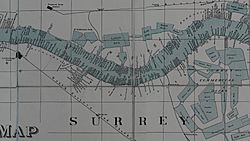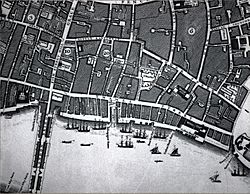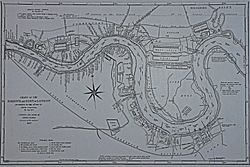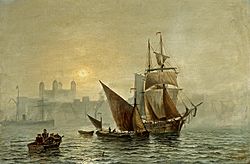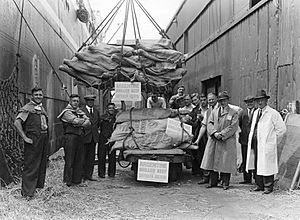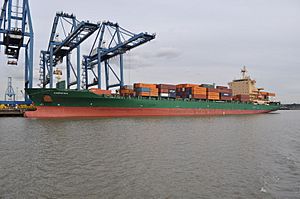Port of London facts for kids
Quick facts for kids Port of London |
|
|---|---|
| Location | |
| Country | United Kingdom |
| Location | Greater London, Essex, Kent |
| Website http://www.pla.co.uk |
|
The Port of London is a very important port located along the River Thames. It stretches from the capital city of London all the way to the North Sea. This port was once the biggest in the world. Today, it is the second largest port in the United Kingdom, right after Grimsby & Immingham.
The Port of London Authority (PLA) manages the port. This group was created in 1908. They are in charge of the tidal part of the River Thames. However, they do not own or run any of the port's facilities themselves.
The Port of London can handle many types of ships. These include large cruise ships, roll-on roll-off ferries, and all kinds of cargo ships. It is not just one place. Instead, it spreads out along the tidal river, even through Central London. It has many different wharfs, docks, and terminals. These have been built over hundreds of years. Like other old European ports such as Antwerp and Rotterdam, most of the port's activities have moved further out to sea. This is because ships have become much bigger. Also, land closer to the city center is now used for other things.
Contents
History of the Port of London
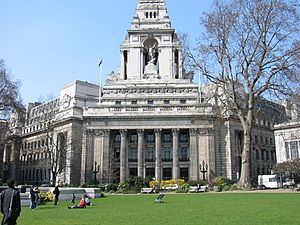
The Port of London has been key to London's economy since the city was founded in the 1st century. It helped London grow and become very successful. In the 1700s and 1800s, it was the busiest port in the world. Its wharves stretched for about 11 miles (18 km) along the Thames. Over 1,500 cranes moved goods, and 60,000 ships used the port each year. During World War II, the port was a main target for the German air force (the Luftwaffe) during The Blitz.
The Roman Port in London
The first signs of a busy trading port in London come from when the Romans controlled Britain. The Romans built the first harbor. They made the waterfront bigger by using wooden frames filled with dirt. After this, they built the wharf in four steps, moving downstream from the London Bridge.
The port quickly grew and became successful in the 2nd and 3rd centuries. It stopped being used for trade in the early 5th century. This happened when the Romans left Britain, and trade slowed down. The changes the Romans made to the riverbanks were so big that it was hard to tell where the natural waterfront originally was. London became a very important trading port for the Romans. The harbor town grew fast. The valuable goods traded there shaped the rich lifestyle of its people. The city did very well under Roman rule. The Roman way of building and organizing the London harbor is still the basis of the port today.
Pool of London
Until the early 1800s, all shipping happened in the Pool of London. This was a part of the River Thames near Billingsgate in the City of London. All goods brought in had to be checked by Customs Officers. This area was known as "Legal Quays".
The Pool saw a huge increase in trade in the late 1700s. Many ships carried coal, as London's population grew and needed more fuel. Coastal trade almost doubled between 1750 and 1796. By 1794, the Pool handled over 3,600 ships and 620,000 tons of goods. The riverbanks were lined with wharves for miles. Hundreds of ships were docked or anchored in the river.
In the late 1700s, there was a big plan to make the Thames straighter. This plan was not fully carried out. However, a smaller channel, the City Canal, was later dug across the Isle of Dogs.
Enclosed Dock Systems
London's Docklands were created because the Pool of London became too small. This was especially true for trade with the West Indies. In 1799, a law allowed a new dock to be built away from the river for goods from the West Indies. Other docks followed as landowners built enclosed docks. These new docks offered better security and facilities than the wharves in the Pool.
Throughout the 1800s, many enclosed dock systems were built. High walls surrounded them to protect goods from river theft. These docks included:
- West India Docks (1802)
- East India Docks (1803)
- London Docks (1805)
- Surrey Commercial Docks (1807)
- St Katharine Docks (1828)
- Royal Victoria Dock (1855)
- Millwall Dock (1868)
- Royal Albert Dock (1880)
- Tilbury docks (1886)
These docks were built by different private companies. By the early 1900s, competition and worker strikes led to calls for them to join together. This led to the creation of the Port of London Authority (PLA) in 1908. In 1909, the PLA took control of most of the enclosed docks. They also took over managing the river from Teddington Lock to Yantlet Creek. The PLA's main office was finished in 1919.
The PLA made the river channel deeper. They also added the King George V Dock (1920) and improved other docks. This led to the expansion of Tilbury in the late 1960s. Tilbury became a major container port. Under the PLA, London's trade grew to 60 million tons by 1939. After World War 2, London recovered and again reached 60 million tons in the 1960s.
Dockworkers
By 1900, the wharves and docks handled about 7.5 million tons of cargo each. This was due to the growing reach of the British Empire. The Port of London was a workplace for many people in the late 1800s and early 1900s.
Most dockworkers were hired for just one day at a time. However, there were skilled workers. Stevedores were good at loading ships. Lightermen moved cargo from ships using barges. These skilled workers often had regular jobs. But the average dockworker lived day-to-day. They hoped to be hired when a ship came in. Sometimes, workers would even pay extra just to get a day's work. A day's work could mean working for 24 hours straight.
The work was also very risky. Around 1900, a dockworker would suffer a serious accident from falling cargo almost every week. Less serious injuries happened even more often.
London dockworkers handled valuable goods from far-off places. These included precious stones, African ivory, Indian spices, and Jamaican rum. They could not afford to buy these things themselves. So, goods sometimes went missing from the docks. Workers might hide items under their clothes when leaving. Sometimes, professional thieves would break into warehouses at night. Taking tobacco, pineapples, or bearskins was common. But the most frequent issue was workers taking and consuming drinks. Many reports from the early 1900s describe dockworkers taking bottles of brandy or gin. They would then consume them instead of working. The consequences were often severe. For example, five weeks of hard labor for one bottle of a drink was not unusual.
These difficult conditions led Ben Tillett to organize the London Dock strike of 1889. The workers asked for only a small pay increase, but the managers first said no. The strike grew over time. It helped to bring attention to the poor conditions of London dockworkers. The strike also helped to restart the British Trades Union movement. This led to better conditions for workers across London.
Port Industries
Many industries grew up around the docks. Some of these still exist today. These include sugar refining, edible oil processing, vehicle manufacturing, and lead smelting. Other industries included working with iron, casting brass and bronze, shipbuilding, timber, grain, cement, and paper milling. London was also a major center for making underwater communication cables for many years.
For centuries, London was the main center for shipbuilding in Britain. However, it became less important compared to places like the Clyde from the mid-1800s. The last large warship, HMS Thunderer, was launched in 1911.
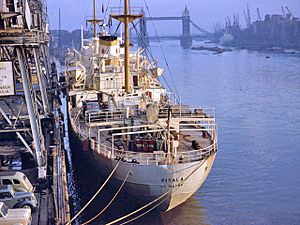
The large number of ships in the Port of London also supported a big ship repair industry. In 1864, there were 33 dry docks for repairing ships. The largest was Langley's Lower Dock at Deptford, which was 460 feet (140 m) long. Even though building large ships stopped in 1912, ship repair continued to do well. By 1930, there were fewer dry docks, but they were more modern. They were designed to repair ships made of iron and steel.
There were also many power stations and gas works along the Thames. Major gas works were at Beckton and East Greenwich. Power stations included Battersea, Bankside, and Tilbury.
These power stations and gas works needed a lot of coal. This made up a large part of London's trade after the war. A 1959 newspaper article said that about two-thirds of the 20 million tons of coal entering the Thames each year was used by these places.
A big reason for the drop in London's trade since the 1960s is the loss of the coal trade. Gas works closed after North Sea Gas was found. People started using gas and electricity for heating instead of coal. All the coal-burning power stations above Tilbury also closed. In 2011, when Tilbury Power Station stopped burning coal, London's coal imports became zero.
The Move Downstream
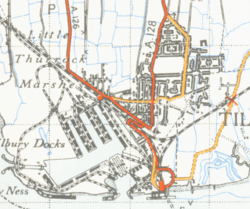
As ships became larger and containerisation became common, the upstream part of the port became less important. The enclosed docks further up the river closed gradually between the late 1960s and early 1980s. Trade at private wharves on the open river continued for a bit longer. For example, container handling happened at the Victoria Deep Water Terminal until the 1990s. Bulk paper was imported at Convoy's Wharf until 2000.
The wider port continued to be a major center for trade and industry. Oil and gas terminals were located at Coryton, Shell Haven, Canvey in Essex, and the Isle of Grain in Kent. In 1992, the government decided to make Tilbury a freeport. The PLA stopped running the port facilities. It kept its role of managing the Thames river.
Much of the unused land in the upstream London Docklands is now being developed. It is being used for homes and as a second financial area for London, around Canary Wharf.
The Port Today
Today, the Port of London has over 70 different terminals and port facilities. These are owned by many different companies. Over 30,000 people work directly at the port. Most of these facilities are located in places like Purfleet, Thurrock, Tilbury, London Gateway, Coryton, and Canvey Island in Essex. Also in Dartford and Northfleet in Kent, and Greenwich, Silvertown, Barking, Dagenham, and Erith in Greater London.
The Port of London handles many types of goods. These include containers, timber, paper, vehicles, aggregates, crude oil, petroleum products, liquefied petroleum gas, coal, metals, grain, and other bulk materials.
In 2012, London was the second largest port in the United Kingdom by the amount of goods handled (43.7 million tons). Grimsby and Immingham was larger with 60 million tons. However, the Port of London handles the most non-fuel cargo of any UK port. In 2007, this was 32.2 million tons. Other big ports in the UK are Felixstowe and Southampton.
The number of twenty-foot equivalent units (TEUs) of containers handled by the Port of London went over two million for the first time in 2007. This continued in 2008. The port's ability to handle large, modern ships and containers is growing a lot. The London Gateway port project will be able to handle up to 3.5 million TEUs per year when it is fully finished.
About 12,500 commercial ships use the Port of London each year. This means it handles about 10% of the UK's commercial shipping trade. It also adds 8.5 billion pounds to the UK's economy. Besides cargo, 37 cruise ships visited the Port in 2008.
The port used to refine a lot of crude oil. Today, it only imports refined products. The Kent (BP) and Shell Haven (Shell) refineries closed in 1982 and 1999. Coryton closed in 2012. Some wharves further up the river are still used. For example, at Silvertown, Tate & Lyle still runs the world's largest cane sugar refinery. It used to be served by the West India Docks, but now has its own cargo handling facilities. Many wharves are used for handling aggregates. These are brought by barge from facilities downriver. Riverside areas in London are very popular for new homes or offices. Because of this, the Greater London Authority and the PLA have a plan to protect 50 wharves.
Images for kids
-
The London docks in 1882. The King George V Dock (and Tilbury Docks, much further downstream) had not yet been built.
See also
 In Spanish: Puerto de Londres para niños
In Spanish: Puerto de Londres para niños


